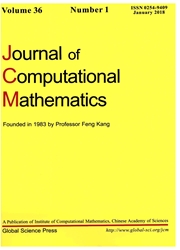

 中文摘要:
中文摘要:
快打扫方法的高顺序最近在文学被开发了高效地解决静态的 Hamilton-Jacobi 方程。与快打扫方法的第一份订单作比较,快大规模的高顺序方法是更精确的,但是因为精确地在流入边界附近对待点是特别地重要的更宽的数字模板,他们经常在边界附近为几个格子点要求另外的数字边界处理,当信息将流进计算领域并且将影响全球精确性。在文学,在这些边界点的数字答案也与准确答案被修理,它不总是是可行的,或与第一顺序 discretization 计算了,它能减少全球精确性。在这篇论文,我们讨论二策略处理流入边界条件。一个人基于快在边界和理查森推测附近与几种不同网孔尺寸打扫方法的第一份订单的数字答案,其它基于一个 Lax-Wendroff 类型过程到反复利用 PDE 以正切的衍生物给正常写空间衍生物到流入边界,从而在格子获得高顺序解决方案值指在流入边界附近。我们用快大规模高度探索这二条途径顺序 WENO 计划在[18 ] 为作为一个代表性的例子解决静态的 Eikonal 方程。数字例子被给表明这二条途径的表演。
 英文摘要:
英文摘要:
High order fast sweeping methods have been developed recently in the literature to solve static Hamilton-Jacobi equations efficiently. Comparing with the first order fast sweeping methods, the high order fast sweeping methods are more accurate, but they often require additional numerical boundary treatment for several grid points near the boundary because of the wider numerical stencil. It is particularly important to treat the points near the inflow boundary accurately, as the information would flow into the computational domain and would affect global accuracy. In the literature, the numerical solution at these boundary points are either fixed with the exact solution, which is not always feasible, or computed with a first order discretization, which could reduce the global accuracy. In this paper, we discuss two strategies to handle the inflow boundary conditions. One is based on the numerical solutions of a first order fast sweeping method with several different mesh sizes near the boundary and a Richardson extrapolation, the other is based on a Lax-Wendroff type procedure to repeatedly utilizing the PDE to write the normal spatial derivatives to the inflow boundary in terms of the tangential derivatives, thereby obtaining high order solution values at the grid points near the inflow boundary. We explore these two approaches using the fast sweeping high order WENO scheme in [18] for solving the static Eikonal equation as a representative example. Numerical examples are given to demonstrate the performance of these two approaches.
 同期刊论文项目
同期刊论文项目
 同项目期刊论文
同项目期刊论文
 The entropy solutions for the Lighthill-Whitham-Richards traffic flow model with a discontinuous flo
The entropy solutions for the Lighthill-Whitham-Richards traffic flow model with a discontinuous flo Revisiting Hughes' dynamic continuum model for pedestrian flow and the development of an efficient s
Revisiting Hughes' dynamic continuum model for pedestrian flow and the development of an efficient s Fast Sweeping Fifth order WENO Scheme for Static Hamilton-Jacobi Equations with Accurate Boundary Tr
Fast Sweeping Fifth order WENO Scheme for Static Hamilton-Jacobi Equations with Accurate Boundary Tr L-2 stability analysis of the central discontinuous Galerkin method and a comparison between the cen
L-2 stability analysis of the central discontinuous Galerkin method and a comparison between the cen Explicit construction of entropy solutions for the Lighthill-Whitham-Richards traffic flow model wit
Explicit construction of entropy solutions for the Lighthill-Whitham-Richards traffic flow model wit Front tracking algorithm for the Lighthill-Whitham-Richards traffic flow model with a piecewise quad
Front tracking algorithm for the Lighthill-Whitham-Richards traffic flow model with a piecewise quad 期刊信息
期刊信息
